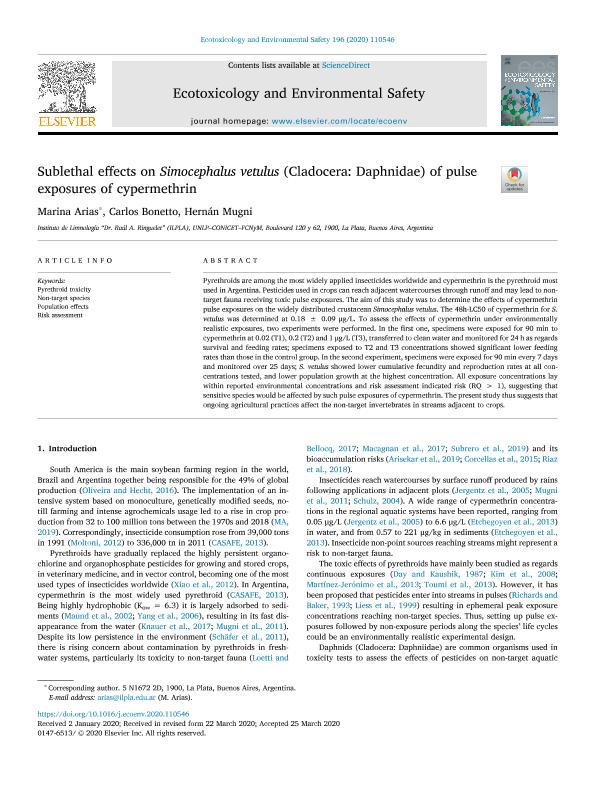Artículo
Sublethal effects on Simocephalus vetulus (Cladocera: Daphnidae) of pulse exposures of cypermethrin
Fecha de publicación:
06/2020
Editorial:
Academic Press Inc Elsevier Science
Revista:
Ecotoxicology and Environmental Safety
ISSN:
0147-6513
Idioma:
Inglés
Tipo de recurso:
Artículo publicado
Clasificación temática:
Resumen
Pyrethroids are among the most widely applied insecticides worldwide and cypermethrin is the pyrethroid most used in Argentina. Pesticides used in crops can reach adjacent watercourses through runoff and may lead to non-target fauna receiving toxic pulse exposures. The aim of this study was to determine the effects of cypermethrin pulse exposures on the widely distributed crustacean Simocephalus vetulus. The 48h-LC50 of cypermethrin for S. vetulus was determined at 0.18 ± 0.09 μg/L. To assess the effects of cypermethrin under environmentally realistic exposures, two experiments were performed. In the first one, specimens were exposed for 90 min to cypermethrin at 0.02 (T1), 0.2 (T2) and 1 µg/L (T3), transferred to clean water and monitored for 24 h as regards survival and feeding rates; specimens exposed to T2 and T3 concentrations showed significant lower feeding rates than those in the control group. In the second experiment, specimens were exposed for 90 min every 7 days and monitored over 25 days; S. vetulus showed lower cumulative fecundity and reproduction rates at all concentrations tested, and lower population growth at the highest concentration. All exposure concentrations lay within reported environmental concentrations and risk assessment indicated risk (RQ>1), suggesting that sensitive species would be affected by such pulse exposures of cypermethrin. The present study thus suggests that ongoing agricultural practices affect the non-target invertebrates in streams adjacent to crops.
Palabras clave:
Pyrethroid toxicity
,
non-target species
,
population effects
,
risk assessment
Archivos asociados
Licencia
Identificadores
Colecciones
Articulos(ILPLA)
Articulos de INST.DE LIMNOLOGIA "DR. RAUL A. RINGUELET"
Articulos de INST.DE LIMNOLOGIA "DR. RAUL A. RINGUELET"
Citación
Arias, Marina; Bonetto, Carlos Alberto; Mugni, Hernan Diego; Sublethal effects on Simocephalus vetulus (Cladocera: Daphnidae) of pulse exposures of cypermethrin; Academic Press Inc Elsevier Science; Ecotoxicology and Environmental Safety; 196; 6-2020; 1-7
Compartir
Altmétricas




